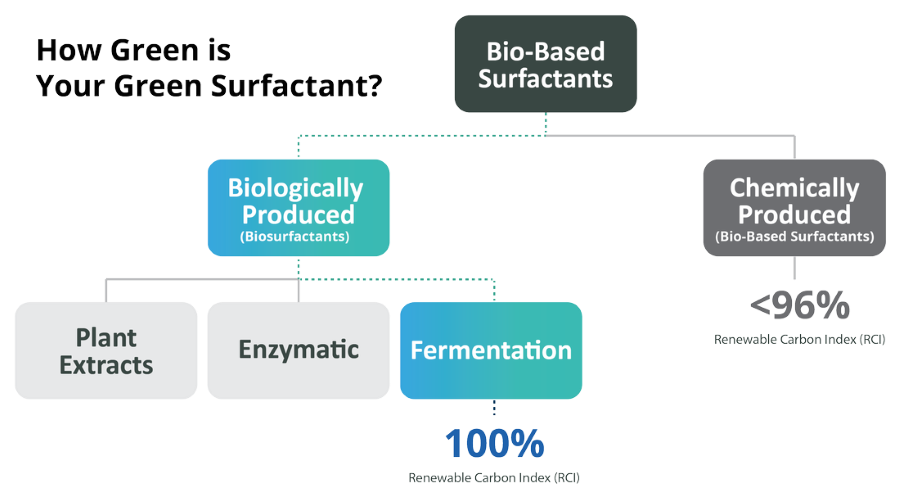Which Natural Surfactants are Superior: Bio-Surfactants or Bio-Based Surfactants?

Today, most product formulations use chemically based surfactants, meaning they’re sourced from non-renewable, petroleum-based raw materials and feedstocks. In an effort to increase environmental responsibility while meeting regulatory requirements and stakeholder demands, surfactant producers have replaced petrochemical-based raw materials with bio-based, renewable feedstocks. These sustainable replacements to chemically based surfactants are known as bio-based surfactants.
There are different types of bio-based surfactants, the most sustainable of which is a classification known as bio-surfactants. Unsurprisingly, with these new developments has come some confusion in terminology, both with product formulators as well as among end users.
There are key characteristics that differentiate legacy, petrochemical surfactants from bio-based surfactants, as well as chemically manufactured bio-surfactants from their biologically created counterparts, bio-surfactants.
What Are Bio-Based Surfactants?
The USDA defines bio-based surfactants as those that are derived “… in whole or significant part of biological products or renewable domestic agricultural materials (including plant, animal, and marine materials) or forestry materials.” In short, all bio-based surfactants are created at least in part from bio-based, renewable feedstocks and raw materials.
Applications of bio-based surfactants span most surfactant market sectors. They are found in laundry detergents, foods, cosmetics, personal care products, pharmaceuticals, paints and coatings, and environmental remediation treatments.
Bio-based surfactants derived from fatty acids and neutral lipids are increasingly popular due to their favorable performance, biodegradability, biocompatibility, and their potential replacement of fossil fuel-derived surfactants. Many consumers prefer buying goods containing bio-based surfactants in an effort to shop sustainably and reduce their personal carbon footprint.
However, there are two key things to know about bio-based surfactants:
1.) Some Bio-Based Surfactants Are Chemically Produced
Manufacturers of bio-based surfactants advertise their products as a sustainable alternative to traditional surfactants. However, the production of many bio-based surfactants requires traditional chemical reactions. These reactions consume substantial levels of heat and electricity generated by hydrocarbon sources — leaving a larger carbon footprint.
For example, many key manufacturers in the global bio-surfactant market produce alkyl polyglucosides (APGs) and glucamides — well-known bio-based sugar surfactants — at an industrial scale. Both APGs and glucamides are developed using renewable starting materials (such as glucose, fatty alcohols, and triglycerides). However, like conventional surfactants, both ingredients are synthetically produced using chemical reactions.
By developing their bio-based surfactants using processes that require fossil fuels, the sustainability claims of many manufacturers are negated.
2.) Bio-Based Surfactants Are Not Always 100% Bio-Based
While all bio-based surfactants contain carbon derived from renewable sources, some also contain carbon from fossil fuels. Classifications have been developed to rank bio-based surfactants based on their starting materials. Two examples include:
· The Renewable Carbon Index (RCI), which grades bio-based surfactants based on their bio content, or the percentage of total carbon derived from plant or agricultural-based sources as opposed to carbon from fossil fuels.
· The European Commission of Standardization (CEN), which classifies surfactants into four categories based on the percentage of renewable carbon (carbon derived from renewable feedstocks) that they contain.
Classifications like these allow surfactants to be categorized as fully bio-based even if they contain fossil-fuel based materials. For example, CEN considers a surfactant “wholly bio-based” as long as it contains more than 95% renewable carbon.

What Are Bio-Surfactants?
Bio-surfactants are bio-based surfactants that contain only bio-based, renewable feedstocks AND are produced using sustainable, non-chemical processes. This means the bio content of bio-surfactants is 100% renewable carbon. It also means that unlike chemically produced bio-based surfactants, bio-surfactants are produced directly from biological processes of microorganisms. Bio-surfactants can be produced from a variety of organic materials, and they are typically classified by their molecular structure — with varying degrees of complexity.
In short, both the formulation and production of bio-surfactants includes fully renewable materials with no hydrocarbon-reliant chemical reactions.
Learn more about the types of surfactants: Putting the FACT in Surfactants: Technical Details
What’s the Difference Between Bio-Surfactants and Bio-Based Surfactants?
Bio-surfactants are a type of bio-based surfactant. Unfortunately, some manufacturers refer to their bio-based surfactants as bio-surfactants, further confusing the terminology. It’s important to note that all bio-surfactants are bio-based surfactants, but not all bio-based surfactants are bio-surfactants.
There are two key differences between bio-based surfactants and bio-surfactants that end users may not realize:
- The bio content;
- How the surfactant is produced.
Based on these two factors, bio-surfactants have proven sustainability and performance advantages compared to bio-based surfactants.
Bio-Surfactants Are More Sustainable Than Bio-Based Surfactants
Bio-surfactants are considered environmentally friendly because they are readily biodegradable and 100% bio-based. Because of this, they do not require rating through the Renewable Carbon Index. However, if rated, bio-surfactants would have the highest possible RCI. Since bio-surfactants are biologically produced, they do not contain any trace chemicals (such as 1,4-Dioxane or other Proposition 65 chemicals) and minimize any toxicity concerns.
The production process of bio-surfactants also exceeds other bio-based surfactants in environmental sustainability. The biological processes used to produce bio-surfactants require far less energy than chemically produced, bio-based surfactants, reducing hydrocarbon use. Biological processes also create fewer toxic byproducts than chemical processes.
Bio-Surfactants Have Better Multi-Functionality Over Bio-Based Surfactants
Bio-surfactants have unique structures that deliver excellent interfacial and biochemical properties. Their diverse functionalities offer positive benefits for a multitude of industrial and CPG applications, including as detergents, emulsifiers, wetting agents and dispersants. Bio-surfactants can act as primary or secondary surfactants with superior performance and lower in-use rates.
Where Can Formulators Find Bio-Surfactants?
Many bio-based surfactant suppliers advertise their products as providing an environmentally sustainable alternative to conventional options. But not all bio-based surfactants are created equal. Only bio-surfactants minimize environmental impact from production to end use while delivering proven performance gains for CPG and industrial suppliers.
U.S.-based supplier Locus Performance Ingredients produces commercial volumes of bio-surfactants, specifically sophorolipids (SLP), that are used globally in industrial and CPG applications, including:
- Personal and home care products (available through Dow);
- Industrial and institutional cleaning products (I&I);
- Coatings, adhesives, sealants and elastomers (C.A.S.E);
- Metalworking fluids;
- Agricultural adjuvants;
- Industrial treatments for water, pulp & paper, and textile & leather.
The company’s microbial sophorolipids, a type of bio-surfactant in the glycolipid class, are produced using novel fermentation methods with a low carbon footprint and are USDA certified as 100% bio-based. The high activity bio-surfactants can be customized to solve a multitude of formulation pain points, including:
- Replacing palm oil-based and petrochemical ingredients;
- Minimizing toxicity;
- Maximizing product performance;
- Reducing carbon intensity.
For more information, click here.
Looking for a reprint of this article?
From high-res PDFs to custom plaques, order your copy today!






